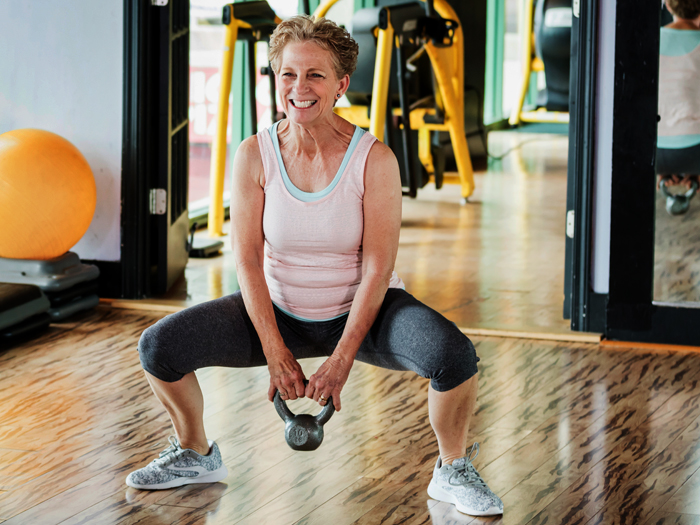The Ultimate Guide to Strength Training for Seniors: Building Strength and Maintaining Independence
Imagine this: You're 75, playing with your grandkids in the park. You effortlessly lift them up for a swing, chase them around the playground without getting winded, and feel a surge of energy you haven't felt in years. This isn't just a dream; it's the reality that strength training for seniors can unlock. It's about maintaining independence, enjoying life to the fullest, and defying the limitations that age often imposes.
Understanding the Profound Strength Training Benefits for Seniors
The benefits of exercise for older adults, especially strength training, extend far beyond simply building bigger muscles. It's a cornerstone of healthy aging, impacting physical and mental well-being in numerous ways. Neglecting strength training as we age can lead to a cascade of negative consequences, including muscle loss (sarcopenia), decreased bone density (osteoporosis), and a higher risk of falls. According to a 2024 study published in the *Journal of Gerontology*, consistent strength training can significantly reduce the risk of falls by up to 40% in individuals over 65. This highlights the critical role it plays in maintaining mobility and independence.
- Increased Muscle Mass and Strength: Counteracts age-related muscle loss, making everyday tasks easier and improving overall physical function.
- Improved Bone Density: Stimulates bone growth, reducing the risk of osteoporosis and fractures.
- Enhanced Balance and Coordination: Strengthens muscles crucial for balance, lowering the risk of falls and injuries.
- Boosted Metabolism: Helps maintain a healthy weight and improves glucose control, reducing the risk of type 2 diabetes.
- Improved Mood and Cognitive Function: Studies show that senior fitness programs can alleviate symptoms of depression and anxiety and enhance cognitive performance.
- Reduced Risk of Chronic Diseases: Can help manage or prevent conditions such as heart disease, arthritis, and back pain.
Essential Types of Muscle Strengthening Exercises for Seniors
Choosing the right types of exercises is crucial for achieving optimal results and minimizing the risk of injury. A well-rounded program should incorporate exercises that target all major muscle groups, with a focus on functional movements that mimic everyday activities.
Upper Body Exercises
These exercises improve upper body strength, making tasks like lifting groceries, reaching for objects, and carrying items easier.
- Bicep Curls: Use dumbbells or resistance bands to strengthen the biceps muscles.
- Overhead Press: Strengthens the shoulders and upper back; can be done with dumbbells or resistance bands.
- Rows: Works the back muscles, improving posture and overall upper body strength; use dumbbells or resistance bands.
- Tricep Extensions: Targets the triceps muscles, helping with pushing movements; use dumbbells or resistance bands.
Lower Body Exercises
These exercises build lower body strength, crucial for walking, climbing stairs, and maintaining balance.
- Squats: A fundamental exercise that strengthens the quads, hamstrings, and glutes. Can be modified by using a chair for support.
- Lunges: Improves balance and strengthens the legs and glutes. Can be done forward, backward, or laterally.
- Calf Raises: Strengthens the calf muscles, improving ankle stability and balance.
- Glute Bridges: Works the glutes and hamstrings, important for hip extension and lower back support.
Core Exercises
A strong core provides stability and support for the spine, improving posture and reducing the risk of back pain. Incorporating these can significantly improve the effectiveness of any weight training for elderly individuals.
- Plank: Strengthens the entire core, including the abs, back, and obliques. Can be modified by performing it on the knees.
- Bird Dog: Improves core stability and balance; performed on hands and knees.
- Pelvic Tilts: Strengthens the abdominal muscles and improves lower back mobility.
- Modified Crunches: Focuses on abdominal strength, supporting the spine.
Designing a Safe Strength Training for Seniors Program
Safety is paramount when designing a strength training for seniors program. It’s essential to start slowly, progress gradually, and listen to your body. Consulting with a healthcare professional or certified fitness trainer is highly recommended, especially if you have any underlying health conditions.
Step-by-Step Guide to Getting Started
- Consult with Your Doctor: Before starting any new exercise program, it’s crucial to get clearance from your doctor. Discuss any health concerns or limitations you may have.
- Assess Your Current Fitness Level: Determine your starting point by evaluating your strength, balance, and mobility. This will help you choose appropriate exercises and set realistic goals.
- Start Slowly and Progress Gradually: Begin with light weights or resistance and gradually increase the intensity and duration of your workouts as you get stronger. Avoid pushing yourself too hard, especially in the beginning.
- Focus on Proper Form: Maintaining correct form is essential to prevent injuries. If you’re unsure about proper technique, seek guidance from a certified fitness trainer.
- Listen to Your Body: Pay attention to any pain or discomfort you may experience during exercise. Stop if you feel any sharp or persistent pain.
Sample Weekly Workout Schedule
This is a sample schedule. Adjust as needed based on your fitness level and preferences. Remember to incorporate balance exercises for seniors and mobility exercises for older adults within your week.
| Day | Exercise Focus | Exercises | Sets/Reps |
|---|---|---|---|
| Monday | Upper Body | Bicep Curls, Overhead Press, Rows | 2-3 sets of 10-12 reps |
| Tuesday | Lower Body | Squats (with chair support if needed), Lunges, Calf Raises | 2-3 sets of 10-12 reps |
| Wednesday | Rest or Active Recovery (walking, stretching) | ||
| Thursday | Core | Plank (modified on knees if needed), Bird Dog, Pelvic Tilts | 2-3 sets of 15-20 reps or hold for 30-60 seconds |
| Friday | Upper Body | Tricep Extensions, Rows, Overhead Press | 2-3 sets of 10-12 reps |
| Saturday | Lower Body | Glute Bridges, Calf Raises, Squats (with chair support if needed) | 2-3 sets of 10-12 reps |
| Sunday | Rest or Active Recovery (yoga, swimming) |
Remember to always warm up before each workout and cool down afterward. Warming up can consist of light cardio, such as walking in place, and dynamic stretching. Cooling down can include static stretching, holding each stretch for 20-30 seconds.
Choosing the Right Equipment
You don’t need expensive equipment to start resistance training for seniors. Simple tools like dumbbells, resistance bands, and even your own body weight can be highly effective.
- Dumbbells: Versatile and effective for a wide range of exercises. Start with light weights (1-3 pounds) and gradually increase the weight as you get stronger.
- Resistance Bands: Affordable and portable, resistance bands provide a variable level of resistance. They are also gentle on the joints.
- Chair: A sturdy chair can be used for support during exercises like squats and lunges. It can also be used for chair exercises for seniors with limited mobility.
- Ankle Weights: Can be used to add resistance to leg exercises, but use with caution, especially if you have joint problems.
Safety Considerations for Exercise for Older Adults
Prioritizing safety is crucial to avoid injuries and ensure a positive exercise experience. Be mindful of the following precautions:
- Warm-up and Cool-down: Always warm up before each workout and cool down afterward to prepare your muscles and prevent injuries.
- Proper Form: Focus on maintaining correct form throughout each exercise to avoid strain and maximize effectiveness.
- Breathing: Breathe properly during exercise. Exhale during the exertion phase and inhale during the relaxation phase.
- Hydration: Drink plenty of water before, during, and after your workouts to stay hydrated.
- Listen to Your Body: Pay attention to any pain or discomfort you may experience. Stop exercising and consult with a healthcare professional if you experience any sharp or persistent pain.
- Avoid Overexertion: Don't push yourself too hard, especially when you're first starting out. Gradually increase the intensity and duration of your workouts as you get stronger.
Troubleshooting Common Challenges
Even with the best-laid plans, you might encounter some challenges along the way. Here are some tips for overcoming common obstacles:
- Pain or Discomfort: If you experience pain or discomfort, stop the exercise and rest. If the pain persists, consult with a healthcare professional. Consider modifying the exercise or using a lighter weight.
- Lack of Motivation: Find a workout buddy, join a senior fitness programs, or set realistic goals to stay motivated. Reward yourself for reaching milestones.
- Time Constraints: Break up your workouts into shorter sessions throughout the day if you have limited time. Even 10-15 minutes of exercise can be beneficial.
- Fear of Injury: Start with chair exercises for seniors and other low-impact activities. Focus on proper form and gradual progression. Consider working with a certified personal trainer who specializes in weight training for elderly individuals.
Pro Tips for Maximizing Results
To get the most out of your strength training for seniors program, consider these pro tips:
- Nutrition: A balanced diet rich in protein is essential for muscle growth and repair. Ensure you're getting enough protein, calcium, and vitamin D.
- Consistency: Consistency is key to achieving long-term results. Aim to exercise at least 2-3 times per week.
- Variety: Vary your exercises to challenge your muscles and prevent boredom.
- Rest and Recovery: Allow your muscles adequate time to recover between workouts. Aim for at least one day of rest between strength training sessions.
- Track Your Progress: Keep track of your workouts and progress to stay motivated and make adjustments as needed.

FAQ: Frequently Asked Questions
Here are some frequently asked questions about strength training for seniors:
- Q: Is strength training safe for seniors? A: Yes, when performed correctly and with proper precautions. Consult with your doctor before starting any new exercise program.
- Q: How often should seniors strength train? A: Aim for 2-3 times per week, with at least one day of rest between sessions.
- Q: What type of equipment do I need? A: You can start with simple tools like dumbbells, resistance bands, or even your own body weight.
- Q: How much weight should I lift? A: Start with light weights that you can lift comfortably for 10-12 repetitions. Gradually increase the weight as you get stronger.
- Q: What if I have arthritis? A: Strength training can actually help improve arthritis symptoms. Focus on low-impact exercises and consult with your doctor or a physical therapist.
- Q: What are the best balance exercises for seniors to incorporate? A: Tai Chi, single-leg stands (holding onto a chair for support), and heel-to-toe walking are excellent options.
Remember, strength training for seniors is an investment in your health and well-being. By following these guidelines and listening to your body, you can enjoy the numerous benefits of exercise and maintain your independence for years to come. Are you ready to start your journey to a stronger, healthier you? Share your questions and experiences in the comments below!
